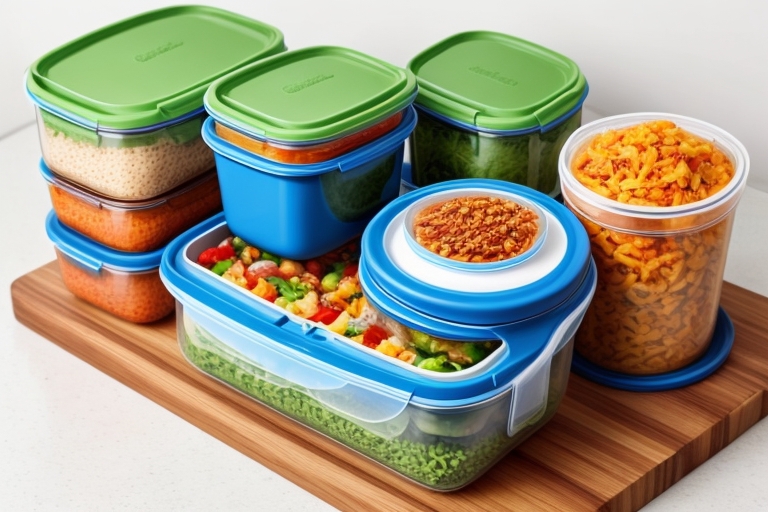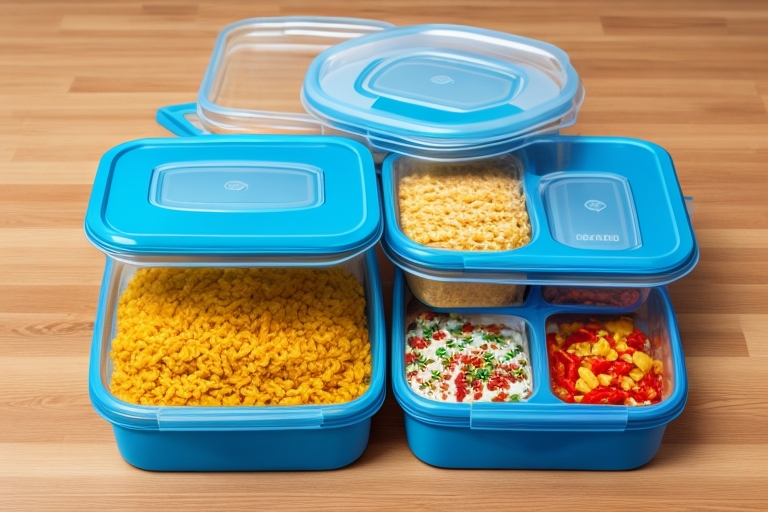
Food storage containers play a crucial role in preserving the freshness of food and minimizing waste. They create a barrier against air, moisture, and bacteria, keeping your edibles in top-notch condition for a longer time.
Now, when it comes to options, the market is a treasure trove of variety. From classic plastic containers to glass jars, vacuum-sealed bags to stainless steel bins, you’ve got choices that cater to different needs. Not to mention the innovation in design—stackable containers, compartmentalized boxes, and even those with special features for specific food items. The world of food storage containers is as diverse as the range of cuisines you can whip up in your kitchen!
Considerations for Choosing Food Storage Containers
Let’s break down the considerations for choosing food storage containers based on materials:
1. Plastic:
- Durability: Plastic containers are lightweight and durable, making them suitable for everyday use. However, they can scratch or warp over time.
- Safety: Opt for containers labeled as BPA-free to avoid potential health risks associated with certain plastics. It’s also crucial to check if they are food-grade and meet safety standards.
- Ease of Cleaning: Many plastic containers are dishwasher-safe, but they may retain odors or stains from certain foods.
2. Glass:
- Durability: Glass containers are sturdy and resistant to scratching, providing long-lasting use. However, they can break if dropped.
- Safety: Glass is considered a safe material for food storage, as it doesn’t leach harmful chemicals. It’s a great option for those concerned about potential health risks.
- Ease of Cleaning: Glass containers are easy to clean and don’t retain odors or stains. They are often safe for dishwasher use.
3. Stainless Steel:
- Durability: Stainless steel containers are highly durable and resistant to dents and scratches. They are a robust option for long-term use.
- Safety: Stainless steel is generally safe for food storage. Ensure that the containers are made from high-quality, food-grade stainless steel.
- Ease of Cleaning: Stainless steel is easy to clean and doesn’t retain odors. Most containers are dishwasher-safe.
Importance of BPA-Free and Food-Grade:
- Choosing containers labeled as BPA-free ensures that you avoid potential health risks associated with this chemical.
- Opting for food-grade containers ensures that the materials meet the necessary safety standards for storing food. This is crucial for maintaining the quality and safety of your stored edibles.
When selecting food storage containers, consider your priorities—whether it’s durability, safety, or ease of cleaning—and make sure they meet the necessary standards for keeping your food fresh and your kitchen safe.
Features to Look for in Food Storage Containers
1. Airtight Seals:
- Importance: Airtight seals are like the guardians of freshness. They prevent air and moisture from sneaking in, keeping your food at its peak for a longer time.
- Benefits: Your fruits stay crisp, and leftovers remain as tasty as the first serving. Plus, airtight containers are ideal for preventing leaks, ensuring your lunch bag or fridge stays mess-free.
2. Stackable Designs:
- Importance: Space in the kitchen is like prime real estate. Stackable containers are the savvy investors, maximizing your storage efficiency.
- Benefits: Say goodbye to cluttered cabinets. Stackable designs save space, making it easy to organize and locate containers when you need them. It’s like a Tetris game, but with Tupperware!
3. Microwave, Dishwasher, and Freezer-Safe:
- Importance: Versatility is the spice of kitchen life. Containers that can handle the heat (and the cold) offer flexibility and convenience.
- Benefits: From reheating leftovers to storing frozen meals and breezy cleanup in the dishwasher—these containers are your kitchen’s all-stars. One container, many uses.
4. Easy to Label:
- Importance: Ever played the guessing game with mystery containers in the fridge? Labeling is the secret weapon for a well-organized kitchen.
- Benefits: No more surprises or science experiments. Easily label your containers, whether it’s the date, contents, or cooking instructions. It’s like giving your food storage a user-friendly interface.
Look for containers that create a sealed fortress against air, embrace the art of efficient stacking, handle temperature extremes with ease, and come with a labeling feature for the ultimate kitchen harmony.
Popular Food Storage Container Brands and Options

Here’s an overview of popular food storage container brands and some of their options:
1. Rubbermaid:
- Overview: Rubbermaid is a well-known brand offering a wide range of storage solutions, including food storage containers.
- Options:
- Sets with Various Sizes: Rubbermaid offers sets with containers of different sizes, suitable for various food storage needs.
- Divided Containers: Some sets include containers with divided compartments, ideal for keeping different food items separate.
- Specialty Containers: Rubbermaid provides specialty containers designed for specific items, such as produce or sandwiches.
- Customer Reviews: Rubbermaid is often praised for its durability, airtight seals, and the variety of sizes available in their sets. Customers appreciate the brand’s commitment to quality and functionality.
2. Pyrex:
- Overview: Pyrex is renowned for its glassware, including versatile and durable glass food storage containers.
- Options:
- Sets with Various Sizes: Pyrex sets typically include glass containers in different sizes, suitable for storing and reheating a variety of foods.
- Divided Containers: Some Pyrex sets feature containers with compartments, allowing you to keep different components of a meal separate.
- Freezer-to-Oven Convenience: Pyrex containers are known for their ability to go from the freezer to the oven safely.
- Customer Reviews: Pyrex is often praised for its durability, resistance to staining and odors, and the transparency of the glass. Customers appreciate the brand’s commitment to producing safe and reliable food storage containers.
3. Tupperware:
- Overview: Tupperware is a pioneer in the food storage industry, known for its durable plastic containers and innovative designs.
- Options:
- Sets with Various Sizes: Tupperware offers sets with containers of different sizes and shapes to accommodate various storage needs.
- Specialty Containers: Tupperware has specialized containers for specific items, such as those designed for marinating, serving, or keeping produce fresh.
- Customer Reviews: Tupperware is often praised for its longevity, airtight seals, and the brand’s commitment to sustainability. Customers appreciate the classic designs and the versatility of Tupperware containers.
When considering food storage container options, customer reviews and ratings indicate that these brands consistently deliver on durability, functionality, and meeting various storage needs. However, individual preferences may vary, so it’s advisable to read reviews specific to the sets or containers you’re interested in to ensure they align with your requirements.
Tips for Using Food Storage Containers
- Label and Date:
- Always label your containers with the contents and date. This helps you keep track of freshness and avoid mystery items in the back of the fridge.
- Use Airtight Containers for Freshness:
- Opt for containers with airtight seals to preserve the freshness of your food. This is especially crucial for items like fruits, veggies, and leftovers.
- Mind the Material:
- Consider the material of your containers based on your needs. Glass is great for reheating, plastic is lightweight, and stainless steel is durable. Ensure they are food-grade and safe for your intended use.
- Avoid Overpacking:
- Don’t overpack containers, especially if you’re freezing food. Leave some space for expansion to prevent containers from cracking.
- Separate and Divide:
- Use divided containers for meal prep to keep different components separate. This helps maintain flavors and textures until you’re ready to eat.
- Rotate and Organize:
- Practice FIFO (First In, First Out) to prevent food from going bad. Place newer items at the back and older ones at the front. Organize containers by size and purpose for easy access.
- Mind the Temperature:
- Let hot food cool slightly before sealing it in a container. Similarly, don’t put extremely cold containers directly into a hot oven to avoid thermal shock.
- Freezer-Friendly Prep:
- If you’re planning to freeze meals, consider using containers designed for freezer storage. Remove excess air to prevent freezer burn.
- Avoid Stacking Hot Containers:
- Allow hot food to cool to room temperature before stacking containers in the fridge or freezer. This prevents uneven cooling and helps maintain the quality of the food.
- Regular Maintenance:
- Check containers regularly for signs of wear, such as cracks or warping, especially for plastic containers. Replace any damaged containers to ensure food safety.
- Consider Microwave-Safe Options:
- If you often reheat food in the microwave, choose containers labeled as microwave-safe to ensure they can handle the heat without releasing harmful substances.
- Invest in Variety:
- Have a variety of container sizes to suit different portions. Smaller containers are great for snacks and sauces, while larger ones are perfect for meal prepping.
By keeping these tips in mind, you’ll not only extend the life of your food but also make your kitchen more organized and efficient.
FAQs
- What materials are best for food storage containers?
- Ideally, look for containers made of BPA-free plastic, glass, or stainless steel. These materials are safe for food storage and don’t leach harmful chemicals.
- Are plastic containers safe for food storage?
- Yes, as long as they are labeled as BPA-free. It’s crucial to avoid using containers that may contain harmful chemicals that can transfer to your food.
- Are glass containers better than plastic for food storage?
- Glass containers are a great alternative to plastic as they are non-toxic and don’t absorb odors. They are also microwave-safe and environmentally friendly, though they can be heavier and more breakable.
- Can I use food storage containers in the microwave?
- Check the container’s label to ensure it’s microwave-safe. Glass and certain plastics are usually safe, but avoid using containers with metal elements.
- What features should I consider when choosing food storage containers?
- Look for airtight seals to keep food fresh, stackable designs for efficient storage, and containers that are easy to clean. Consider the size and shape based on your storage needs.

Pingback: Are Plastic Food Storage Containers Recyclable?